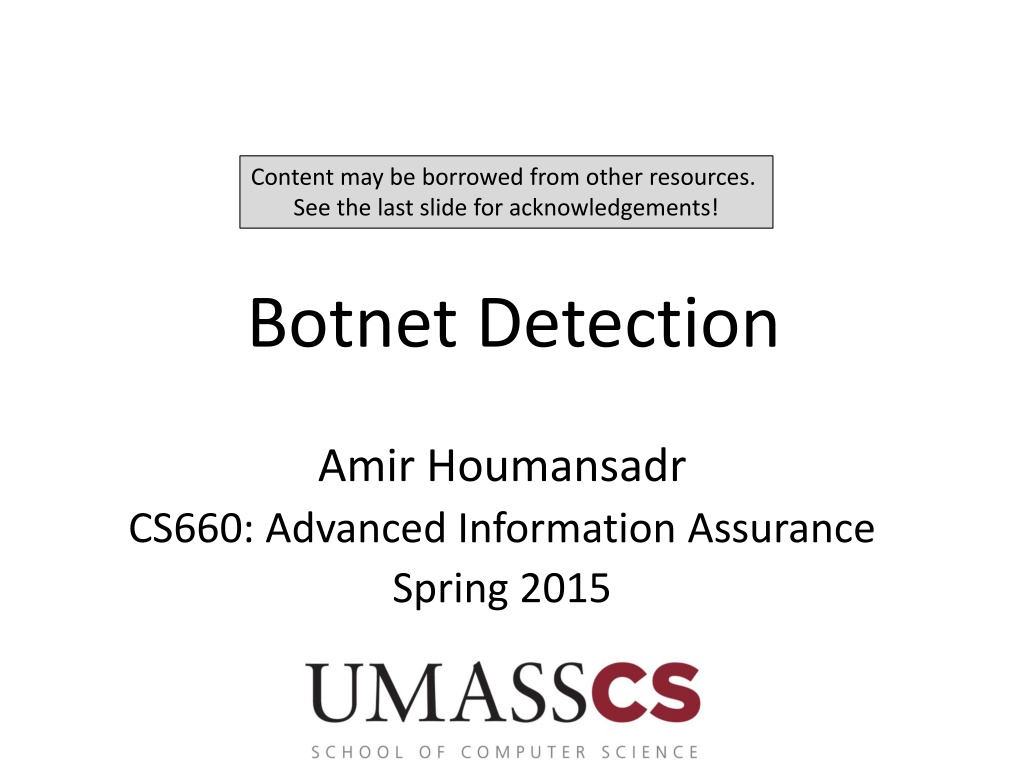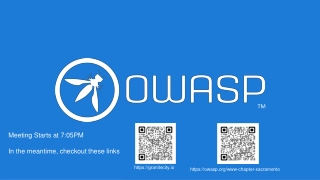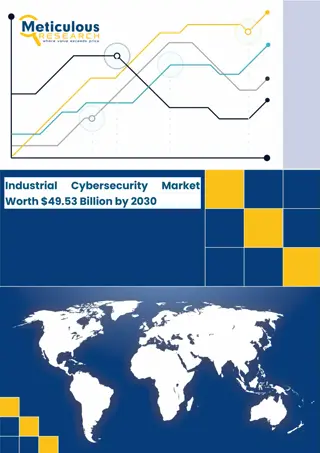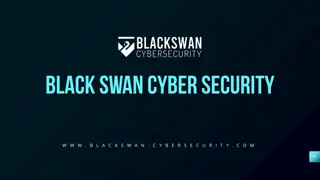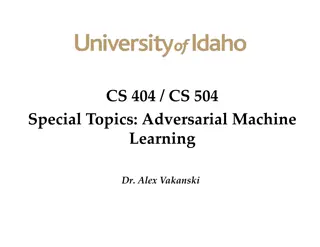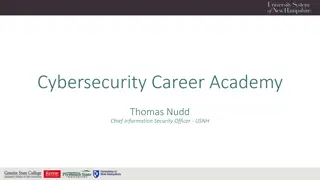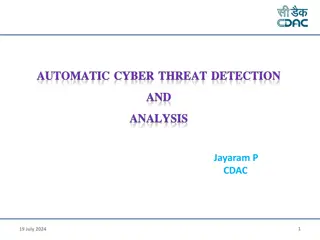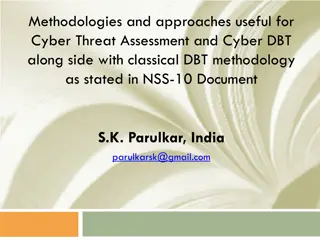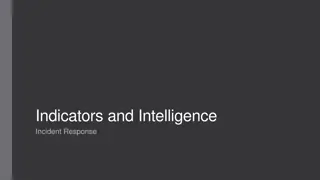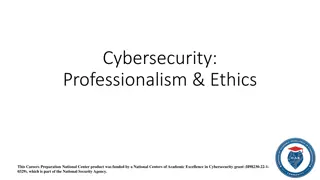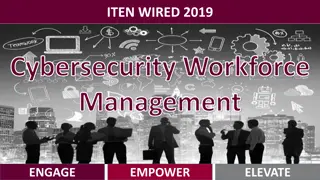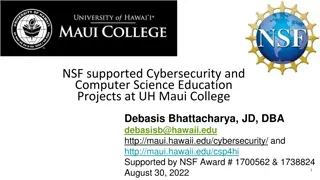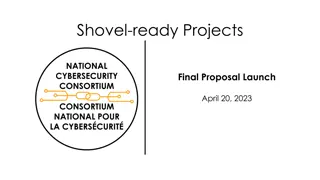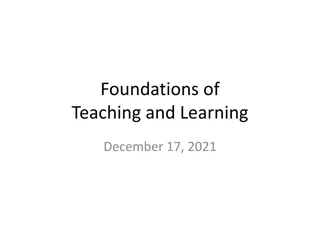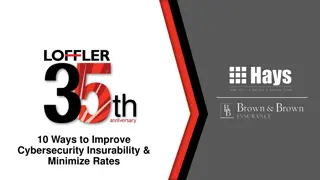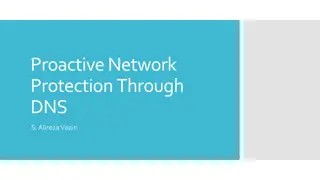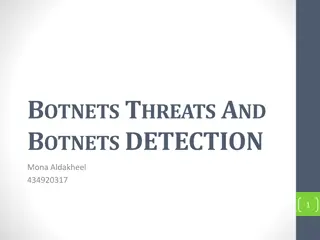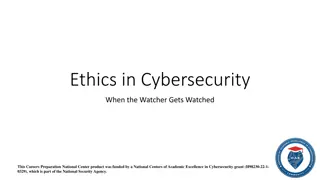Understanding Botnets: A Threat to Cybersecurity
Explore the world of botnets, malware instances that operate on compromised computers without consent. Learn about the structure of botnets, the role of Command and Control channels, and the top botnets like Zeus and Koobface. Discover the widespread impact of botnets and the need for robust detection and prevention strategies in the cybersecurity landscape.
Download Presentation

Please find below an Image/Link to download the presentation.
The content on the website is provided AS IS for your information and personal use only. It may not be sold, licensed, or shared on other websites without obtaining consent from the author. Download presentation by click this link. If you encounter any issues during the download, it is possible that the publisher has removed the file from their server.
E N D
Presentation Transcript
Content may be borrowed from other resources. See the last slide for acknowledgements! Botnet Detection Amir Houmansadr CS660: Advanced Information Assurance Spring 2015
What is a Bot? A malware instance that runs autonomously and automatically on a compromised computer (zombie) without owner s consent Profit-driven, professionally written, widely propagated You might have seen them before in chat rooms, online games, etc.
What is a Botnet Botnet (Bot Army): network of bots controlled by criminals Definition: A coordinated group of malware instances that are controlled by a botmaster via some C&C channel Coordinated: do coordinated actions Group: yes, it s a group of bots! Botmaster: meet the cybercriminal C&C channel: command and control channel CS660 - Advanced Information Assurance - UMassAmherst 3
CS660 - Advanced Information Assurance - UMassAmherst 4
Structures Centralized IRC channels HTTP Distributed P2P CS660 - Advanced Information Assurance - UMassAmherst 5
Breadth Numerous variations of botnets According to a study in 2013 by Incapsula, more than 61 percent of all Web traffic is now generated by bots 25% of Internet PCs are part of a botnet! ( - Vint Cerf) It s a real threat! CS660 - Advanced Information Assurance - UMassAmherst 6
What is the Command and Control (C&C) Channel? The Command and Control (C&C) channel is needed so bots can receive their commands and coordinate fraudulent activities The C&C channel is the means by which individual bots form a botnet
Amercias 10 Most Wanted Botnets 1. Zeus (3.6 million) 2. Koobface (2.9 million) 3. TidServ (1.5 million) 4. Trojan.Fakeavalert (1.4 million) 5. TR/DIdr.Agent.JKH (1.2 million) 6. Monkif (520,000) 7. Hamweq (480,000) 8. Swizzor (370,000) 9. Gammima (230,000) 10. Conficker (210,000) Source
What are they used for? Distributed Denial-of-Service Attacks Spam Phishing Information Theft Distributing other malware
Botnet Detection is Hard! One out of four PC infected Bots are stealthy on infected machines Botnets are dynamically evolving and becoming more flexible Static and signature-based approached less effective Come in many variations Centralized/distributed, different channels, etc. There s no one-size-fits-all solution
Existing Techniques not Effective AntiVirus tools are evaded need to update frequently Bots use rootkit Intrusion detection systems Do not have a big picture Past research aims are too specific Some apply to specific type of botnet (e.g., IRC-based only, or centralized only) Some apply to specific instances of botnet CS660 - Advanced Information Assurance - UMassAmherst 11
BotMiner Observation: Bots part of a botnet have similar communications Bots part of a botnet take similar actions Bots stay there for long term Approach: Let s find machines that have correlated (similar) communication and actions over time CS660 - Advanced Information Assurance - UMassAmherst 12
BotMiner Analysis is done over two planes: C-plane (Communication plane): who is talking to whom, and how A-plane (Activity plane): who is doing what CS660 - Advanced Information Assurance - UMassAmherst 13
BotMiners Main Architecture CS660 - Advanced Information Assurance - UMassAmherst 14
MAIN COMPONENTS OF BOTMINER DETECTION SYSTEM 1.C-PLANE MONITOR 2.A-PLANE MONITOR 3.C-PLANE CLUSTERING 4.A-PLANE CLUSTERING 5.CROSS-PLANE CORRELATOR
Traffic Monitors C-PLANE MONITOR Captures network flows and records information on who is talking to whom The fcapture tool was used (very efficient on high-speed networks) Each flow record contained: time, duration, source IP, destination IP, destination port, and # packets/bytes transferred in both directions A-PLANE MONITOR Logs information on who is doing what Based on Snort (open-source intrusion detection tool) Capable of detecting scanning activities, spamming, and binary downloading
C-plane Clustering Responsible for reading logs generated by the C-plane monitor and finding clusters of machines that share similar communication patterns Start Irrelevant traffic flows are filtered out (2 steps: basic filtering and white-listing) After basic filtering and white-listing, traffic is reduced further by aggregating related flows into communication flows (C-flows)
C-plane Clustering Given an epoch E (1 day) A communication flow (C-flow) is determined by: protocol (TCP or UDP) source IP destination IP Port All matching TCP/UDP flows are aggregated into the same C-flow
Vector Representation of C-flows To apply clustering algorithms to C-flows they must be translated into suitable vector representation A number of statistical features are extracted from each C-flow and then they are translated into a d-dimensional pattern of vectors. Given a C-flow, the discrete sample distribution is computed for 4 variables: 1. The number of flows per hour (fph) 2. The average # of bytes per second (bps) 3. The number of packets per flow (ppf) 4. The average # of bytes per packet (bpp)
CS660 - Advanced Information Assurance - UMassAmherst 21
2-Step Clustering Clustering C-flows is very expensive Because the % of machines in a network that are infected by bots is generally small, the authors separate the botnet-related C-flows from a large number of benign C-flows To cope with the complexity of clustering the task is broken down into steps
A-plane Clustering In this stage, 2 layer clustering is performed on activity logs A scan activity could include scanning ports (e.g, two machines scanning the same ports) Another feature could be target subnet/distribution (e.g. when machines are scanning the same subnet) For spam activity, two machines could be clustered together if their SMTP connection destinations are highly overlapped In the paper, the authors cluster scanning activities according to the destination scanning ports
Cross-Plane Clustering The idea is to cross-check both clusters (A-PLANE & C-PLANE) to find out whether there is evidence of the host being a part of a botnet The first step is to compute the bot score s(h) for each host h on which at least one kind of suspicious activity has been performed Host that have a score below a certain threshold are filtered out The remaining most suspicious host are grouped together according to a similarity metric that takes into account A-PLANE and C-PLANE clusters Two hosts in the same A-luster and at least one common C-cluster are clustered together Hierarchical clustering
Evaluations Tested performance on several real-world network traces (campus network) C-PLANE and A-PLANE monitors were ran continuously for 10 days Collected 6 different botnets (IRC and HTTP) Two P2P botnets, namely Nugache (82 bots) and Storm(13 bots); the network trace lasted a whole day
Detection Results CS660 - Advanced Information Assurance - UMassAmherst 28
Limitations of BotMiner Can adversaries who know how BotMiner work evade it? Or decrease its accuracy? CS660 - Advanced Information Assurance - UMassAmherst 29
Evading C-PLANE Monitoring and Clustering Evasion Method Manipulate communication patterns Examples Switch between multiple C&C servers Randomizing individual communication patterns (e.g. injecting random packets in a flow or by padding random bytes in a packet) Bots could use covert channels to hide their actual C&C communications
Evading A-plane Monitoring and Clustering Evasion Method Performing very stealthy malicious activities Vary the way bots are commanded in the same monitored network Example Scan very slow (e.g. send one scan per hour) The botmaster sends out different commands to each bot
Evading Cross-Plane Analysis The botmaster can send commands that are extremely delayed tasks Malicious activities are performed on different days Trade-off: The botmaster also suffers because as the C&C communications slow down, efficiency of controlling the bot army declines
Acknowledgement Some of the slides, content, or pictures are borrowed from the following resources, and some pictures are obtained through Google search without being referenced below: Latasha A. Gibbs s slides for BotMiner Guofi Gu s slides CS660 - Advanced Information Assurance - UMassAmherst 33
